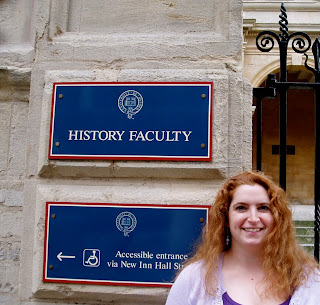
Knowing that we had an afternoon free in Oxford (having decided to take the morning tour) I decided that I couldn't visit Oxford and the Bodleian without at least trying to arrange appointments with other archival institutions in the town. I was fortunate enough that staff at both institutions I contacted were willing and enthusiastic about a visit.
The first appointment was at the History Faculty Library. I was intrigued to view Oxford's history library compared to Harvard's. My contact at the History Faculty Library was Valerie Lawrence, Deputy Librarian, who graciously agreed to discuss the HFL and her experience as librarian.
Once I found the Library, located in the Old Indian Institute (identified by an elephant weathervane), I climbed a gracefully-curved staircase and arrived at the circulation desk where Ms. Lawrence greeted me by name. It was a wonderful appointment: Ms. Lawrence was font of information about the History Faculty Library and took the time to provide some background information about how the library system at Oxford works: the relationship between the Bodleian, the college libraries and the faculty libraries being of particular interest.
During a tour of the library, we started a conversation that covered the origins of the History Faculty Library, their collections, cataloguing system, and the library's role within the broader Oxford library and university system, the future of the library, and her own role as Deputy Librarian. I left HFL with a real understanding of how the libraries within the university functioned and the changing but still crucial role that faculty libraries play for faculty members as well as students.
Like all libraries at Oxford (except college libraries as explained in the previous blog), the HFL is open to all to all University students and staff with reader cards, though it's primary purpose is to serve the needs of the History Faculty, meaning, in Oxford parlance, the undergraduates, graduate students and professors who read and teach history. The HFL is, interestingly, a lending library where all the books circulate. Unlike the history library at Harvard which was for reference only, the Oxford History Faculty library, with 85,000 titles, lends books to students that were published in the Victorian era. Additionally, this is a living library that purchases new books with each academic year to meet reading list requirements. Their collection is especially strong in English history, Western European history, Art history, history of Science, and the library staff have worked to improve their collection of U.S. history.
Unlike the Bodleian which dates it's founding with precision, the History Faculty Library's origins are murky: it began as a gentleman's collection based in the basement of the examination rooms. The library moved into it's current location in 1968 and has already outgrown the space. They have 59 seats to serve 1000 undergraduates and 3-400 graduate students.
 The space itself seemed custom made for reading--abundant natural light, an energetic color palette (white and coral) and a sense of space and airiness. Due to space constraints the collection is almost exclusively printed books--printed journals have been weeded out and electronic versions made available.
The space itself seemed custom made for reading--abundant natural light, an energetic color palette (white and coral) and a sense of space and airiness. Due to space constraints the collection is almost exclusively printed books--printed journals have been weeded out and electronic versions made available.  The library has shifted in the past decade to more emphasis on undergraduate services with some interesting implications: the collection has less material in foreign languages--acquisitions are geared to English-language publications and English-language translations. They often acquire multiple copies of popular texts--two for lending and one for reference. They work with the Bodleian and college libraries to assure that enough copies are available. They use the Union catalogue and are shifting classification to Library of Congress Subject Headings. They do still need to re-catalogue over 10,000 records that remain in a card catalogue.
The library has shifted in the past decade to more emphasis on undergraduate services with some interesting implications: the collection has less material in foreign languages--acquisitions are geared to English-language publications and English-language translations. They often acquire multiple copies of popular texts--two for lending and one for reference. They work with the Bodleian and college libraries to assure that enough copies are available. They use the Union catalogue and are shifting classification to Library of Congress Subject Headings. They do still need to re-catalogue over 10,000 records that remain in a card catalogue.The library was not only an impressive space, their experience provided an illustration of how libraries evolve to meet the needs of their community. A presence on Facebook and Twitter, research guides to the History collection on popular topics: Modern History, pre- and post-1945 US history, Primary sources online, include bibliographical information as well as annotations about the contents of the resources.
To paraphrase Ms. Lawrence: part of being a librarian is the ability to acquire knowledge--and I truly appreciated the time she took to share her knowledge. And I must say, I was much more impressed with Oxford's History Faculty Library than I was with the History library I used in my first graduate degree. The library at Harvard might have looked more "traditional"--with dark wood and brooding graduate students, but the collection at Oxford is a living thing--adjusting to the needs of the faculty and working hard to maintain it's place within the orbit of Oxford's libraries.
Sounds like a great library and tour- good job.
ReplyDelete